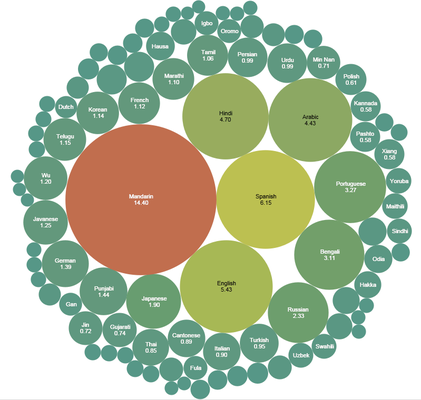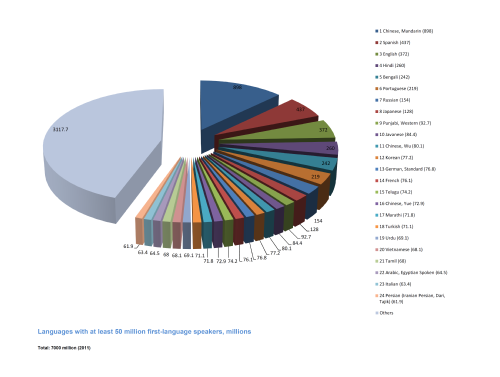List of languages by number of native speakers
This article ranks human languages by their number of native speakers.
However, all such rankings should be used with caution, because it is not possible to devise a coherent set of linguistic criteria for distinguishing languages in a dialect continuum.[1] For example, a language is often defined as a set of varieties that are mutually intelligible, but independent national standard languages may be considered to be separate languages even though they are largely mutually intelligible, as in the case of Danish and Norwegian.[2] Conversely, many commonly accepted languages, including German, Italian and even English, encompass varieties that are not mutually intelligible.[1] While Arabic is sometimes considered a single language centred on Modern Standard Arabic, other authors describe its mutually unintelligible varieties as separate languages.[3] Similarly, Chinese is sometimes viewed as a single language because of a shared culture and common literary language.[4] It is also common to describe various Chinese dialect groups, such as Mandarin, Wu and Yue, as languages, even though each of these groups contains many mutually unintelligible varieties.[5]
There are also difficulties in obtaining reliable counts of speakers, which vary over time because of population change and language shift. In some areas, there is no reliable census data, the data is not current, or the census may not record languages spoken, or record them ambiguously. Sometimes speaker populations are exaggerated for political reasons, or speakers of minority languages may be under-reported in favour of a national language.[6]
Top languages by population
Ethnologue (2019, 22nd edition)
The following languages are listed as having at least 10 million first language speakers in the 2019 edition of Ethnologue, a language reference published by SIL International, which is based in the United States.[7]
Nationalencyklopedin (2010)
This section needs to be updated. The reason given is: the 2010 edition of Nationalencyklopedin has revised figures. (November 2018) |
The following table contains the top 100 languages by estimated number of native speakers in the 2007 edition of the Swedish encyclopedia Nationalencyklopedin. As census methods in different countries vary to a considerable extent, and given that some countries do not record language in their censuses, any list of languages by native speakers, or total speakers, is effectively based on estimates. Updated estimates from 2010 are also provided.[11]
The top eleven languages have additional figures from the 2010 edition of the Nationalencyklopedin. Numbers above 95 million are rounded off to the nearest 5 million.
| Rank | Language | Native speakers in millions 2007 (2010) |
Percentage of world population (2007) |
|---|---|---|---|
| 1 | Mandarin (entire branch) | 935 (955) | 14.1% |
| 2 | Spanish | 390 (405) | 5.85% |
| 3 | English | 365 (360) | 5.52% |
| 4 | Hindi[a] | 295 (310) | 4.46% |
| 5 | Arabic | 280 (295) | 4.23% |
| 6 | Portuguese | 205 (215) | 3.08% |
| 7 | Bengali | 200 (205) | 3.05% |
| 8 | Russian | 160 (155) | 2.42% |
| 9 | Japanese | 125 (125) | 1.92% |
| 10 | Punjabi | 95 (100) | 1.44% |
| 11 | German | 92 (95) | 1.39% |
| 12 | Javanese | 82 | 1.25% |
| 13 | Wu (inc. Shanghainese) | 80 | 1.20% |
| 14 | Malay (inc. Indonesian and Malaysian) | 77 | 1.16% |
| 15 | Telugu | 76 | 1.15% |
| 16 | Vietnamese | 76 | 1.14% |
| 17 | Korean | 76 | 1.14% |
| 18 | French | 75 | 1.12% |
| 19 | Marathi | 73 | 1.10% |
| 20 | Tamil | 70 | 1.06% |
| 21 | Urdu | 66 | 0.99% |
| 22 | Turkish | 63 | 0.95% |
| 23 | Italian | 59 | 0.90% |
| 24 | Yue (inc. Cantonese) | 59 | 0.89% |
| 25 | Thai | 56 | 0.85% |
| 26 | Gujarati | 49 | 0.74% |
| 27 | Jin | 48 | 0.72% |
| 28 | Southern Min (inc. Hokkien and Teochew) | 47 | 0.71% |
| 29 | Persian | 45 | 0.68% |
| 30 | Polish | 40 | 0.61% |
| 31 | Pashto | 39 | 0.58% |
| 32 | Kannada | 38 | 0.58% |
| 33 | Xiang | 38 | 0.58% |
| 34 | Malayalam | 38 | 0.57% |
| 35 | Sundanese | 38 | 0.57% |
| 36 | Hausa | 34 | 0.52% |
| 37 | Odia (Oriya) | 33 | 0.50% |
| 38 | Burmese | 33 | 0.50% |
| 39 | Hakka | 31 | 0.46% |
| 40 | Ukrainian | 30 | 0.46% |
| 41 | Bhojpuri | 29[b] | 0.43% |
| 42 | Tagalog (Filipino) | 28 | 0.42% |
| 43 | Yoruba | 28 | 0.42% |
| 44 | Maithili | 27[b] | 0.41% |
| 45 | Uzbek | 26 | 0.39% |
| 46 | Sindhi | 26 | 0.39% |
| 47 | Amharic | 25 | 0.37% |
| 48 | Fula | 24 | 0.37% |
| 49 | Romanian | 24 | 0.37% |
| 50 | Oromo | 24 | 0.36% |
| 51 | Igbo | 24 | 0.36% |
| 52 | Azerbaijani | 23 | 0.34% |
| 53 | Awadhi | 22[b] | 0.33% |
| 54 | Gan | 22 | 0.33% |
| 55 | Cebuano (Visayan) | 21 | 0.32% |
| 56 | Dutch | 21 | 0.32% |
| 57 | Kurdish | 21 | 0.31% |
| 58 | Serbo-Croatian | 19 | 0.28% |
| 59 | Malagasy | 18 | 0.28% |
| 60 | Saraiki | 17[c] | 0.26% |
| 61 | Nepali | 17 | 0.25% |
| 62 | Sinhala | 16 | 0.25% |
| 63 | Chittagonian | 16 | 0.24% |
| 64 | Zhuang | 16 | 0.24% |
| 65 | Khmer | 16 | 0.24% |
| 66 | Turkmen | 16 | 0.24% |
| 67 | Assamese | 15 | 0.23% |
| 68 | Madurese | 15 | 0.23% |
| 69 | Somali | 15 | 0.22% |
| 70 | Marwari | 14[b] | 0.21% |
| 71 | Magahi | 14[b] | 0.21% |
| 72 | Haryanvi | 14[b] | 0.21% |
| 73 | Hungarian | 13 | 0.19% |
| 74 | Chhattisgarhi | 12[b] | 0.19% |
| 75 | Greek | 12 | 0.18% |
| 76 | Chewa | 12 | 0.17% |
| 77 | Deccan | 11 | 0.17% |
| 78 | Akan | 11 | 0.17% |
| 79 | Kazakh | 11 | 0.17% |
| 80 | Northern Min[disputed ] | 10.9 | 0.16% |
| 81 | Sylheti | 10.7 | 0.16% |
| 82 | Zulu | 10.4 | 0.16% |
| 83 | Czech | 10.0 | 0.15% |
| 84 | Kinyarwanda | 9.8 | 0.15% |
| 85 | Dhundhari | 9.6[b] | 0.15% |
| 86 | Haitian Creole | 9.6 | 0.15% |
| 87 | Eastern Min (inc. Fuzhou dialect) | 9.5 | 0.14% |
| 88 | Ilocano | 9.1 | 0.14% |
| 89 | Quechua | 8.9 | 0.13% |
| 90 | Kirundi | 8.8 | 0.13% |
| 91 | Swedish | 8.7 | 0.13% |
| 92 | Hmong | 8.4 | 0.13% |
| 93 | Shona | 8.3 | 0.13% |
| 94 | Uyghur | 8.2 | 0.12% |
| 95 | Hiligaynon/Ilonggo (Visayan) | 8.2 | 0.12% |
| 96 | Mossi | 7.6 | 0.11% |
| 97 | Xhosa | 7.6 | 0.11% |
| 98 | Belarusian | 7.6[d] | 0.11% |
| 99 | Balochi | 7.6 | 0.11% |
| 100 | Konkani | 7.4 | 0.11% |
| Total | 5,610 | 85% |
Charts and graphs
Bubble chart of languages by proportion of native speakers worldwide[11]
Languages with at least 50 million first-language speakers, millions (according to: Ethnologue[13])
See also
- Global language system
- Languages of Africa
- Languages used on the Internet
- Linguistic demography
- Linguistic diversity index
- List of ISO 639-3 codes
- List of languages by number of native speakers in India (uses a different definition of Hindi)
- List of languages by the number of countries in which they are recognized as an official language
- List of languages by total number of speakers
- List of sign languages by number of native signers
- Lists of languages
- Number of languages by country
- World language
Notes
- ^ Refers to only Modern Standard Hindi here. The Census of India defines Hindi on a loose and broad basis. It does not include the entire Hindustani language, only the Hindi register of it. In addition to Standard Hindi, it incorporates a set of other Indo-Aryan languages written in Devanagari script including Awadhi, Bhojpuri, Haryanvi, Dhundhari etc. under Hindi group which have more than 422 million native speakers as of 2001.[12] However, the census also acknowledges Standard Hindi, the above mentioned languages and others as separate mother tongues of the Hindi language and provides individual figures for all these languages.[12]
- ^ a b c d e f g h This is only a fraction of total speakers; others are counted under "Hindi" as they regard their language a Hindi dialect.
- ^ Numbers may also be counted in Punjabi above
- ^ Only half this many use Belarusian as their home language.
References
- ^ a b Paolillo, John C.; Das, Anupam (31 March 2006). "Evaluating language statistics: the Ethnologue and beyond" (PDF). UNESCO Institute of Statistics. pp. 3–5. Retrieved 17 November 2018.
- ^ Chambers, J.K.; Trudgill, Peter (1998). Dialectology (2nd ed.). Cambridge University Press. ISBN 978-0-521-59646-6.
- ^ Kaye, Alan S.; Rosenhouse, Judith (1997). "Arabic Dialects and Maltese". In Hetzron, Robert (ed.). The Semitic Languages. Routledge. pp. 263–311. ISBN 978-0-415-05767-7.
- ^ Norman, Jerry (1988). Chinese. Cambridge University Press. p. 2. ISBN 978-0-521-29653-3.
- ^ Norman, Jerry (2003). "The Chinese dialects: phonology". In Thurgood, Graham; LaPolla, Randy J. (eds.). The Sino-Tibetan languages. Routledge. pp. 72–83. ISBN 978-0-7007-1129-1.
- ^ Crystal, David (1988). The Cambridge Encyclopedia of Language. Cambridge University Press. pp. 286–287. ISBN 978-0-521-26438-9.
- ^ a b "Summary by language size". Ethnologue. Retrieved 12 March 2019. For items below #26, see individual Ethnologue entry for each language.
- ^ "World Population Clock: 7.7 Billion People (2019) - Worldometers". www.worldometers.info. Retrieved 31 March 2019.
- ^ a b Hindi and Urdu are often classified as standardized registers of a single Hindustani language.
- ^ a b Defined at the national border rather than by language
- ^ a b Mikael Parkvall, "Världens 100 största språk 2007" (The World's 100 Largest Languages in 2007), in Nationalencyklopedin. Asterisks mark the 2010 estimates for the top dozen languages.
- ^ a b Abstract of speakers' strength of languages and mother tongues – 2000, Census of India, 2001
- ^ Summary by language size
External links
- The Ethnologue's most recent list of languages by number of speakers
- Languages Spoken by More Than 10 Million People (Archived 2009-10-31) – Encarta list, based on data from Ethnologue, but some figures (e.g. for Arabic) widely vary from it
- Map of World Languages. Download of MP3 audio files in 1600 language combinations.


